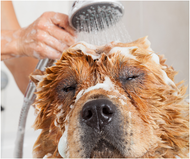Top Tips For Grooming Your Dog At Home
Posted by Darren Walton on 28th Jun 2022
Just like with humans, proper bathing and grooming is vital for their health and well-being.
Grooming your dog at home can be a cost-effective way to keep them looking and feeling their best.
Brush The Coat Regularly
All dogs should have regular brushing sessions, but they're essential if your dog has a long coat. Not only does it help to remove dirt and debris, but it also helps distribute the oils evenly along the length of their fur, keeping their coat healthy and shiny.
While some people use a human hairbrush, we recommend using one specifically designed for dogs. The bristles are softer and won't be harsh on your pet's skin, which is why it's best to purchase a proper grooming brush.
Start at the neck and work your way down, but be especially careful around sensitive areas like the stomach and armpits. If you find any mats or tangles in their fur, carefully try to tease them apart with your fingers or a comb before using a brush.
Bathe Your Dog Regularly
There's no set recommendation on how often your dog should have a bath, but most professionals would say once a month. However, this entirely depends on your dog's lifestyle and coat type.
For example, a dog who is happier at home and goes for walks on the lead will need comparably fewer baths than an active breed that loves playing in the mud and swimming in lakes.
However, you might want to bathe them more often if they have a skin condition or tend to get smelly quickly - but once a week should be the maximum amount.
When bathing your dog, use a gentle shampoo and lukewarm water. Be sure to rinse all the soap off its fur and avoid getting any in the eyes. Ideally a shampoo for dogs should be used to ensure it is suitable for their skin and coat. There are specific shampoo's for a number of conditions including dry or scaly skin, oily skin etc.
Towel dry them afterwards, making sure to get their coat completely dry - especially the tail.
Nail Trimming
A dog's nails should be trimmed every few weeks, and it's not the most straightforward job to do at home. Most professionals will recommend that a vet or specialist groomer perform this task. Always use the right tool for the job with specialist dog nail clippers and files available for all sizes of dog.
There are plenty of tutorials online, but if you're not familiar with trimming your dog's nails, you might clip close to the quick, which causes a lot of pain, bleeding and, in some cases, infections.
If you want to trim your dog's nails at home, pay attention when the vet or groomer does it, and that way, you can protect your pup and avoid accidents.
Brushing Teeth
Like humans, brushing your dog's teeth is an integral part of their oral health. Not only does it help remove plaque and tartar build-up, but it also helps fight bad breath.
When it comes to dental care for dogs, special toothbrushes and pastes are available. Start by brushing the outside of their teeth, then move on to the inside. Be sure to get all the way down to the gum line and the back of their mouth.
If your dog is resistant to having its teeth brushed, start by slowly getting them used to the sensation. Reward them with a treat when they let you brush without any fuss.
Cleaning Around The Eyes
Dogs can get a build-up of dirt, tears and other debris around their eyes, which causes irritation.
To clean this area:
1.Use a damp cloth and wipe away any excess gunk.
2.Be careful not to get the cloth too wet as it could irritate your dog's eyes further.
3.If there is any discharge or redness, consult your vet.

